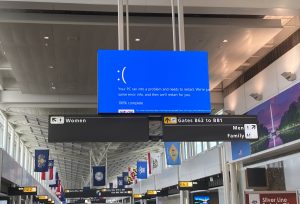
The CrowdStrike Catastrophe: Glitch Paralyzed Industries
In an era where technology drives almost every facet of business, a single software glitch can send shockwaves through the global economy. This was starkly illustrated in July 2024, when a massive system failure at CrowdStrike, a leading cybersecurity firm, caused widespread disruption across several major industries, including airlines, financial services, and healthcare. Here’s a breakdown of what happened, why it matters, and what entrepreneurs can learn from this unprecedented event.
The Glitch That Stunned the Business World
On July 19, 2024, businesses around the world were plunged into chaos due to a software deployment failure at CrowdStrike.
This incident wasn’t the result of a cyberattack but rather a flaw in CrowdStrike’s automated testing process. A bug in their Rapid Response Content side of the Falcon security suite allowed erroneous data to be approved and deployed, affecting millions of systems worldwide.
The ripple effect was immediate and severe: airlines grounded flights, banks halted transactions, and healthcare services were disrupted, showcasing the vulnerabilities in our interconnected digital infrastructure.

How the Failure Unfolded
CrowdStrike’s faulty update caused systems to crash, leading to a boot loop that could only be resolved by technicians with direct access to the affected machines. This meant that for many businesses, operations came to a grinding halt.
The issue began in Australia, where companies reported seeing the Blue Screen of Death (BSOD) on their Windows machines. As Europe started the workday, the problem escalated, grounding flights and causing widespread disruptions.

Airlines were particularly hard hit, with Delta Airlines reporting losses of $500 million due to the cancellation of over 5,000 flights and significant delays in another 1,700 flights. United Airlines also experienced substantial disruptions, although not as severe as Delta, with about 266 flights canceled over the weekend following the glitch. Thousands of flights were canceled worldwide on Saturday, July 20, 2024, and passengers faced long wait times at airports.
The financial sector and public services were not spared either. Banks faced transaction halts, and in the UK, the National Health Service (NHS) warned of delays in patient services due to the system outages. Clinics in Yorkshire, Cheshire, the West Midlands, and Chorley were unable to take appointments. The 911 emergency response system in the US was also affected, with significant dropouts reported across several states, including New York, Washington, Atlanta, Florida, Texas, Arizona, California, Missouri, Michigan, and Illinois.
The Aftermath and Economic Impact
The immediate economic impact of the CrowdStrike failure was staggering.

As a direct consequence of this issue, Airlines alone faced billions in losses due to grounded flights and stranded passengers. Delta Airlines was the worst affected, with CEO Ed Bastian confirming the $500 million loss, which included not only lost revenue but also compensation to customers for delays and cancellations. The financial sector saw halted transactions and diminished customer trust, while healthcare services had to deal with delays and the potential risk to patient care.
By Monday, July 22, 2024, Microsoft estimated that as many as 8.5 million Windows PCs were affected by the faulty update. Although this represented less than 1% of all Windows machines, the impact on critical systems was profound. Affected devices included those used by airlines, 911 operators, mass transit, banking, and health services.
On top of that the breach raised significant questions about the robustness of automated software deployment processes and the importance of thorough testing. The realization that even a leading cybersecurity firm could suffer such a critical failure prompted a reevaluation of existing security and operational protocols across industries.
Lessons for Entrepreneurs
The CrowdStrike incident offers several crucial lessons for entrepreneurs and small business owners. First and foremost, it underscores the importance of investing in robust and thoroughly tested cybersecurity measures. Even if your business is not a direct target, being part of a larger network means you can still be affected by such incidents. Ensuring your systems are regularly audited and updated is essential.
Secondly, diversification of security providers can mitigate risks. Relying on a single cybersecurity firm, no matter how reputable, can leave you exposed if they suffer a glitch. Using a combination of security solutions can provide an added layer of protection.
Finally, having a solid incident response plan is crucial. Knowing how to quickly and effectively respond to a system failure can significantly reduce its impact. This includes regular backups of critical data, clear communication strategies, and predefined steps to restore operations.
Conclusion: Navigating the New Cyber Landscape
The CrowdStrike system failure was a wake-up call for businesses worldwide. It highlighted the vulnerabilities inherent in our digital infrastructure and the catastrophic consequences of ignoring comprehensive cybersecurity measures. For entrepreneurs, this incident serves as a stark reminder of the importance of proactive measures in safeguarding their businesses.
In today’s interconnected world, cybersecurity is not just a technical issue. It is a fundamental business concern. By investing in comprehensive security measures, diversifying providers, and preparing for potential incidents, entrepreneurs can protect their businesses from similar threats. As the digital landscape continues to evolve, staying vigilant and adaptable is the key to navigating these challenges successfully.



























